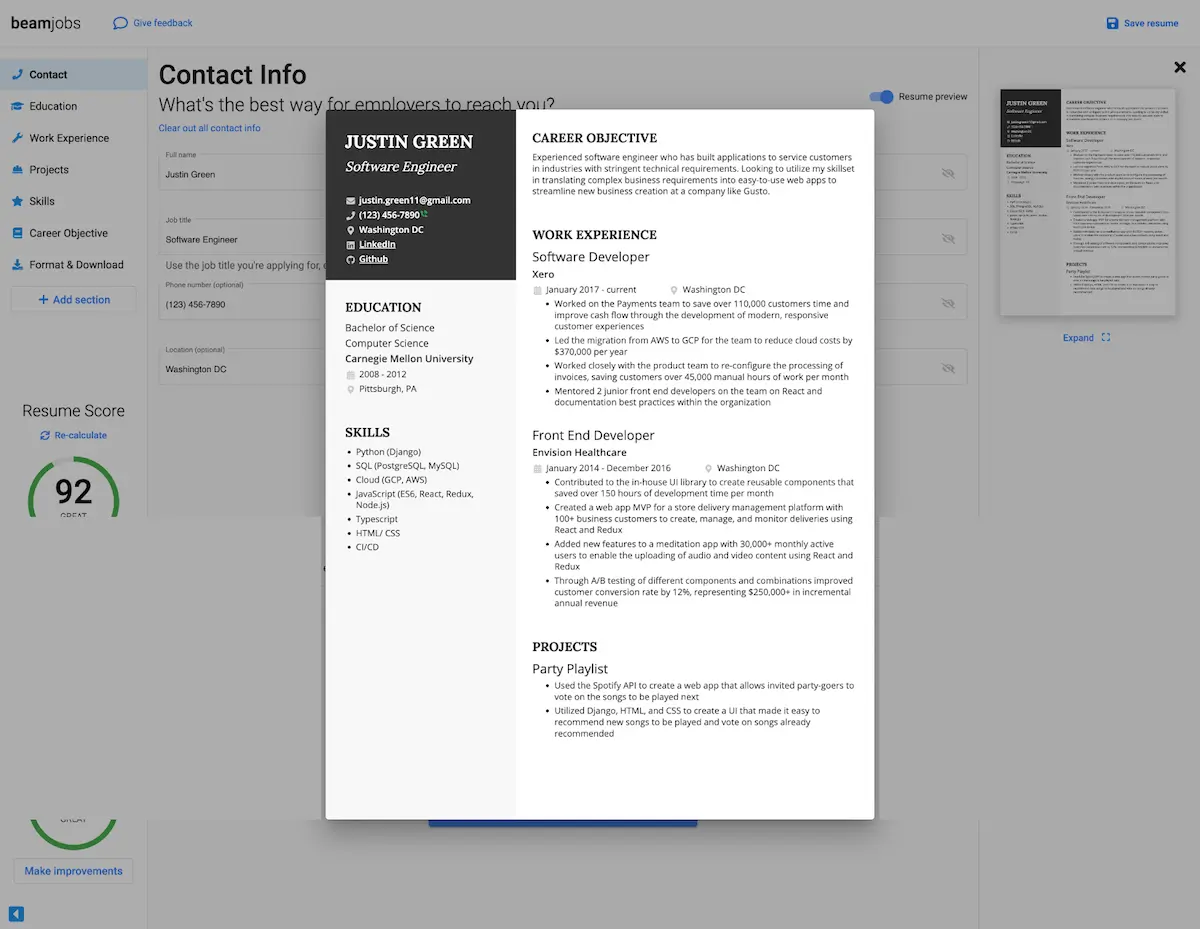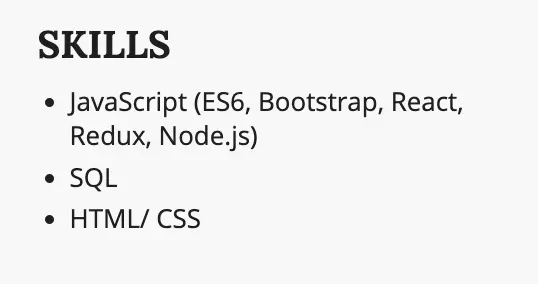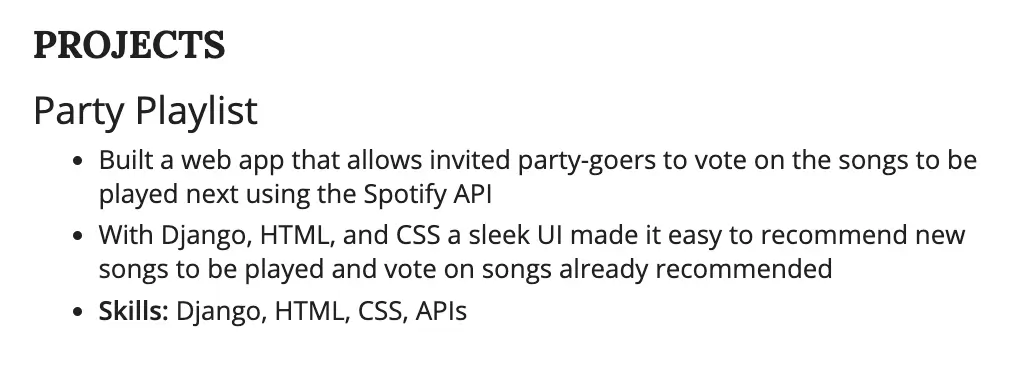Looking for a job as a software engineer? That’s exciting! Whether you’re changing careers or just looking for your next job, this fast-growing industry offers career development opportunities galore. Plus, it can pay quite well.
With great pay and growth potential, the job hunt can be competitive. If you want a shot at a job interview, you need to know how to write a compelling software engineering resume, and you’ll want to create a web developer portfolio.
Writing your first resume, or revamping your old one, can feel daunting. It doesn’t have to be complicated. We’ll walk you through the resume writing process step-by-step and give you plenty of software engineer resume examples. You won’t feel overwhelmed after reading this!
In this complete guide, you’ll learn the following:
- Do software engineers even need a resume?
- How to write a software engineer resume: Step-by-step
- Step 1: Work out your structure
- Step 2: Gather your information
- Step 3: Fill in your contact information
- Step 4: Add your three most relevant work experiences
- Step 5: List your education
- Step 6: Include your skills
- Step 7: Share your certifications and awards
- Step 8: List your software engineering projects
- Step 9: Write your introductory statement
- Step 10: Proofread
- Mistakes to avoid when creating a software engineer resume
- Where to go for great software engineer resume templates
- Wrap-up
Let’s start with the basics; why do you even need a resume?
1. Do software engineers even need a resume?
Yes, software engineers need a resume. Many developers will tell you they’ve gotten multiple job offers with just a resume. Of course, they might not mention that they also had an active GitHub history, polished portfolio, or connection in the industry. But that’s beside the point.
The number one reason you need a resume to land a software engineering job is that almost every job you apply for will require you to have one. But secondly, your resume is how you’ll showcase your transferable skills.
Even if you don’t have much experience with software engineering, you still need to create a software engineer resume. A compelling document with all your most relevant experience will showcase how you learned to code and the skills you can transfer to your new role.
You can also optimize your resume for applicant tracking systems (ATS)–but we’ll discuss that later. First, let’s learn how to create a software engineer’s resume that wins.
2. How to write a software engineer resume step-by-step
Okay, so we’re all on the same page now–you need a resume! But how do you write one? Buckle up! This is where we walk you through the resume writing process–one step at a time.
This section may seem a bit long, but that’s because we’re going to go into every single part of your software engineer resume and make it as compelling as possible. Feel free to start writing your resume in another window while you read through each step. Learning while doing is often the most effective way!
Step 1: Work out your structure
Resume layout (design) and copy (words) go hand-in-hand. If you don’t budget your words for the space you have, you won’t be able to fit it all on one page. It’s helpful to begin by choosing a resume template or layout.
There are templates all over the internet for free that you can use! More on that later. If you don’t want to use a template, you can use the outline in Step 2 below to create your layout in a word processor, PDF maker, or graphic design tool.
Step 2: Gather your information
Before filling in your resume, open up a blank document or your notes app to gather the information you’ll need for your resume. If you’ve already optimized your LinkedIn for the job search, you might want to pull that up too.
Here’s what you should include in your software engineer resume, from top to bottom:
- Contact information
- Introduction paragraph
- Work experience
- Education
- Skills
- Certifications and awards (optional)
- Projects (optional)
Here’s a software engineer resume example with a great layout from BeamJobs. There’s even enough room to include certifications and awards in the left-hand column!

Step 3: Fill in your contact information
Here’s what you need to include in this section:
- First and last name
- Job title, branding statement, or subtitle
- Email address
- Cell phone number
- LinkedIn profile
- GitHub URL
- Website (optional)
- Social media profiles (optional)
- Physical address (optional)
Your contact information is the simplest part of writing a resume. But it’s being analyzed by recruiters as much as the rest of what you’ve written. Here are some tips for making this section as small and effective as possible.
Under your name, you can include a subtitle listing your current job title or a one-sentence personal description. If you don’t have a current job title, you can put the job title you’re looking for or a more creatively branded title. For example, you could put “Entry-Level Software Engineer” or “Skilled Full-Stack Developer.”
Firstly, if you want to come across as professional, make sure your email address isn’t your old AOL email address. I’ll admit it! My email was bandgeek1264@aol.com until I got to college. But I would never put that on a resume. Instead, my email is a polished version of my first and last name with no numbers.
To save space, you don’t need to include your physical address unless you apply for a fully in-person job that favors locals. You don’t need to include your social media profiles unless you’re a thought leader in the industry. You can also omit your website if you don’t have a software engineer portfolio website.
Here’s what your resume contact information section might look like, courtesy of Resume Worded:

Step 4: Add your three most relevant work experiences
When you think about writing your resume, this is probably what you imagined. This part will be easier if you’ve already optimized your LinkedIn for the job hunt. If you haven’t, budget some time to gather everything you need.
Before you dive into writing this section, you will need the following:
- A list of all of your relevant work experience (anything with transferable skills or software engineering)
- Data points from your jobs to demonstrate your achievements
- Information about your bootcamp, professional training program, or college (if you’re new to software development)
Once you have these items, you can start with the basics. Pick your top three-to-five most relevant experiences. Format each job on your list to reflect the structure outlined below.
Here’s how to structure each of your experiences:
- Job title – bolded
- Company name and the location where you worked – standard text
- Dates of employment – italicized
Keep your structure consistent throughout your resume. There’s no right or wrong way to choose whether you’ll abbreviate. But if you abbreviate one state you worked in, abbreviate them all. If you spelled out the entire month of your employment, spell out every month.
Next, list them chronologically, beginning with your most recent experience. Here’s the creative part! It’s time to describe your work experiences. It’s best to list three to five bullet points per experience.
In your bullet points, include some quantifiable accomplishments that are data-proven and action verbs relating to tech but not jargon. Keep your tone present and active, not passive.
This is a software engineer resume example, also from Resume Worded:

Step 5: List your education
If you’re a career changer, your college education might not be relevant to the job you’re applying for now.
Regardless, you should still include it. If you don’t have much experience, you should include information about your software engineer education here in five bullet points. Cover what you learned, how you got hands-on experience, and the projects you did.
If you already have software engineering experience, this section isn’t as important for you. You can simply include where you went to school and one bullet or less about relevant coursework.
Whether you’re new to software development or not, you can elaborate on your undergraduate and graduate degrees in certain circumstances. If you were a double major or had a minor, you can list that too on your software engineer resume. If you had a phenomenal GPA, you could list it. But if your GPA was less than 3.8, you can leave it out.
Here’s how to format your education:
- Name of program or degree—bolded
- Institution and location—standard text
- Dates attended—italicized
Each job you apply for will use a specific naming convention in the description like BS, b.s., bachelor’s degree, bootcamp, or boot camp. Try to edit this to match every job description. You may not always fit the education level specified in the listing. That doesn’t matter! You should still apply for it if you think you’d be a good fit.
Here’s an example of what your software engineering resume might look like if you took CareerFoundry’s Full-Stack Web Development Program:

Step 6: Include your skills
The skills section might be where you shine! Hiring managers and recruiters are looking for specific development skills and that’s why you should list them in the job description. For each coding job you apply for, you can customize this section to fit the job description.
It shouldn’t need to be stated but—don’t lie! Run through the job description and pick the skills you’re proficient in. In this section, it’s usually best to only list hard skills. Group your skills by Expert, Advanced, and Familiar.
Step 7: Share your certifications and awards (optional)
If you have any certifications or awards, include this section! But if you don’t, skip to Step 8. Keep this section of your software engineer resume brief. You only need one line per award; you can simply list each award or certification and the date you received them.
Certifications can serve as proof to your employer that you’ve achieved a certain skill level. If that skill or certification is in the job description, include it in your resume. Whatever you list, include both the full name and the abbreviation. Obviously, only include certifications you’ve actually earned.
For example, a software engineer’s resume skill section might look like this:

Step 8: List your software engineering projects (optional)
If you’re looking to apply for software engineering jobs, you’ve probably worked on a few projects by now. Whether personal projects, open source, internships, freelance, or bootcamps projects, you can use them on your resume.
Career changers and anyone new to software development should take advantage of this section. If you already have experience in software engineering, you probably don’t need this—simply list your portfolio in your contact information and move on to Step 9.
Before you fill in this section, you’ll need a list of the projects you’ve worked on. If you have more than three, group your projects by type. You can use whatever categories seem fitting to you but consider ones like business projects, user interface projects, technical projects, mobile development, etc.
Here’s how to format your projects in your software engineer resume:
- Project Title—bolded
- 2-sentence description—standard text
- Skills—italicized
This is what your projects section might look like:

You can hyperlink the title of your project to a portfolio piece with more details, the live project, or your GitHub.
Stop now if your resume can’t fit on one page with more than just the title. But if you still have room, include a description of the problem your project solved, why you created it, and the client you made it for. Then, list the skills or tech stack you used to create the project.
Step 9: Write your introductory statement
It might be odd to see the introductory statement as one of the last steps in the software engineer resume-writing process. Even though this goes at the top of your resume, we recommend you write it last. It’s much easier to write it at the end for most people.
A summary statement is essentially an introductory paragraph. You’ll use these three-to-five lines to inject some personality into your resume. This is the first thing the interviewer will see.
There are two ways you can approach this. You can either treat it as a summary or an objective. If you already have experience in software engineering, you can summarize your skills, experience, notable accomplishments, and education. If you don’t have experience, you’ll want to opt for an objective.
With an objective, you’ll share tangible achievements from your bootcamp, professional training, college, or internship. You’ll also want to point out your transferable skills and career goals.
This is the most challenging part of writing your resume. You’ll have less than 8 seconds to make a good impression on a recruiter or hiring manager. So, think of this paragraph as a hook to get them to keep reading. Here’s how to maximize your summary statement.
Your summary statement should touch on the following:
- Your unique strengths, expertise, and transferable skills
- Your personality traits that are relevant to the job
- Notable achievements
- The type of position or industry you’re seeking
Wherever possible, mention numbers or statistics to back up your statements. Rewrite your summary for every single job you apply for. It may feel tedious, but if you tailor it to that company and that role specifically, you’re far more likely to get straight to the recruiter screen and land an interview.
Step 10: Proofread
They might not notice if you have a spelling mistake on your resume, but typos never look good! Your summary paragraph is the most crucial thing to edit, but it doesn’t hurt to check over the entire thing. You can use AI editing software like Grammarly, or enlist a friend to proofread it. Better yet, ask your career counselor or mentor–if you have one!
Mistakes to avoid when creating a software engineer resume
Okay, that might be a lot of information. We’re almost through with this complete guide. But before we let you go, we want to let you in on a few things you shouldn’t do when you’re writing your resume.
Don’t use the same exact resume for every job you apply for
While it’s tempting to write your resume once and walk away, it’s not that simple. You should create your resume and edit it for each job you apply to. Adjust the objective statement, skills, and experience to reflect keywords in the job description.
Don’t include any sensitive information on your resume
In the US you don’t need to include your date of birth, social security number, political affiliations, religion, or other personal details. These are dangerous to include, and they’re not relevant to the person who’s going to be reading your resume.
Don’t use fancy graphics
These days, most companies use ATS (Applicant Tracking Systems) to screen applicants before sending software engineer resumes to a hiring manager or recruiter. Make your resume as text-based as possible: most ATS can’t read graphics well.
Don’t send in your resume as a word document
Save it as a PDF before you submit it.
Don’t let your resume exceed one page
If you can’t fit it all, omit the optional sections, trim down your experience descriptions, or reduce the skills you’ve included.
Where to go for great software engineer resume templates
If you want to use a resume template, ensure they’re ATS-friendly. There are plenty of beautiful templates out there with graphics and charts that won’t help you get an interview.
There are hundreds of places you can go to get resume templates online. There are free and paid options. Most offer both free and paid versions. We rounded up the best resume template sites for software developers. Our favorites are the ones that tech professionals or coders created.
Here are our top five favorite resume template sites:
- BeamJobs—made by tech professionals for career changers, diverse tech workers, and experienced developers.
- Career Cup—founded by Gayle Laakmann McDowell, author of Cracking The Coding Interview
- Resume Worded—LinkedIn and resume optimizer
- Kick Resume—a generic resume builder
- JobScan—exclusively ATS-friendly resume builder
Wrap-up
Writing a software engineer resume is not easy, but it doesn’t have to be complicated. As long as you remember to proofread your work, use a few keywords from the job description, and stay away from graphics, you’ll be golden.
Whatever you do, tailor your resume to the job you’re applying for and include a unique introductory paragraph. And if you want to use a resume template, ensure it’s ATS-friendly. With these tips and the steps we outlined, you’re sure to write a stellar software engineer resume.
You’ve just finished the complete guide to writing a software engineer resume. Now get started creating yours, and prepare to apply for jobs. Good luck!
As students of CareerFoundry’s Full-Stack Web Development Program reach the end of their studies, they get paired up with a career specialist. You’ll work closely with them to connect the dots between your previous accomplishments with your newfound coding skills.
Together, you’ll create a winning software engineer resume that showcases your talent, and carefully craft your online presence to appeal to tech employers. You’ll also fine-tune your technical interview skills, learning how to confidently market your experience and negotiate salaries.
If you’d like to learn more about the world of coding, check out these articles:
